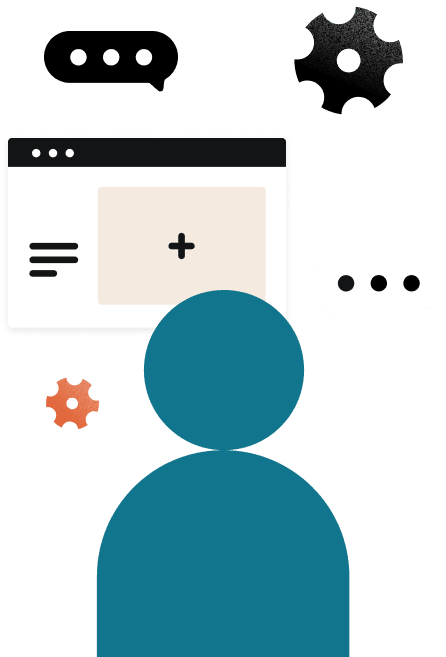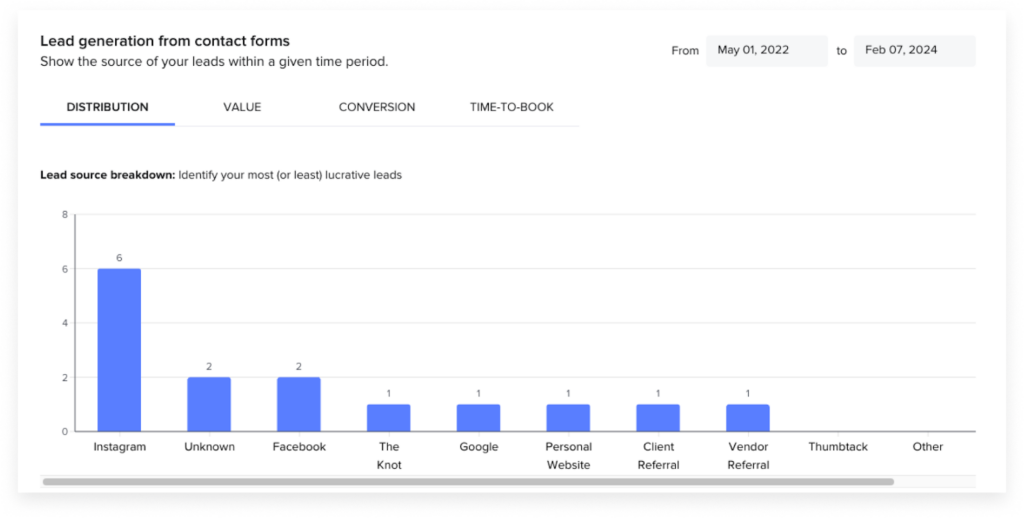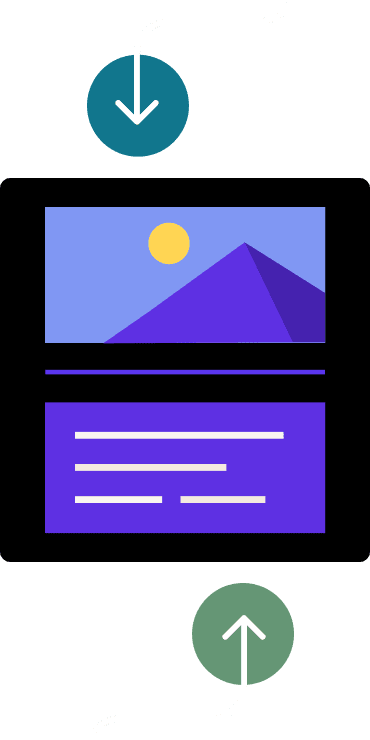Understanding each lead source you have is crucial for gaining more qualified leads, and eventually, clients. Learn about six of the most common lead sources and how you can use a targeted strategy for each.

Winning new clients is a fundamental part of growing your business. However, the process of growing your client base is not always obvious for a small business owner. If you don’t know where to begin the client acquisition process, you can start by identifying where leads find you and determine which lead sources lead to more qualified prospects.
Lead sources can be tied to any of your marketing and advertising efforts. Here, you’ll learn more about lead sources, different lead types, and the best ways to identify qualified leads and convert them into clients.
Jump to:
- What is a lead source?
- Why lead sources matter
- 6 types of lead sources
- How to identify priority lead sources
- Lead source tracking
- How to build strategies for every lead source
- Start winning new clients by focusing on priority lead sources

Use HoneyBook to capture leads and book instantly in a single step.
What is a lead source?
The first step is understanding a lead source meaning in order to know how to strategize to your advantage. A lead source is the path by which a potential customer discovers your business and engages with you. To become a lead, this might mean they offer their information in exchange for a downloadable worksheet, or they schedule an initial consultation. Part of your marketing strategy should maximize lead generation, which is why many of your lead generation sources will be the same channels you use to promote your business.
There are a wide variety of lead sources. However, not every lead source will work the same for every business. It’s important to prioritize lead sourcing that will win your ideal clients in order to make the most of your marketing resources. To do so, you should understand the most common lead types and how they work.

Why lead sources matter
Understanding your lead sources can transform your marketing campaigns by providing you with valuable insight into how and why your target audience is finding you. With this information, you can target your audience with messages that address the needs and buying intent of an ideal client. Identifying the most valuable lead sources can help you:
- Focus your time, budget, and resources on the channels that deliver quality leads and generate a high marketing ROI.
- Nurture your leads until they are ready to convert by tailoring content and interactions based on a specific marketing channel.
- Create personalized marketing campaigns that enhance the prospect’s journey while shortening the sales cycle.
6 types of lead sources
Different types of lead sources align directly with the marketing channels you might already be using. Lead generation in digital marketing involves channels like social media, your blog, and your digital ads. Your leads can also come from traditional channels like print ads and word-of-mouth referrals, though these can be more difficult to track. Here are some of the most effective sources for lead generation.
Social media
Social media marketing is an excellent way to create awareness of your business. Channels like Facebook, Instagram, LinkedIn, and TikTok offer a great place to communicate with current and former clients, and potential clients can discover you and start engaging with your content.
The best social media platforms for lead generation depend on your business. Here are different ways you could leverage some of the top social media channels:
- Facebook: One of the most broadly used social media sites in the world, Facebook allows you to target people by a wide range of demographics and makes sharing content easy. As a business, you can leverage paid Facebook lead generation ads or simply link your contact form on your page to capture organic leads.
- Instagram: Since Instagram is an image-based platform, it works best for creative independents or those that leverage their personal brand to promote professional services. For example, personal coaches, designers, and photographers thrive on Instagram. Using Stories, Reels, and Feed Posts, Instagram gives you a variety of formats to promote lead magnets, then link a contact form in your bio to capture interested clients.
- LinkedIn: This platform is designed to help people build professional connections, which makes it ideal for B2B companies. LinkedIn could be a critical lead source if you provide services that make businesses operate better.
- TikTok: This short video platform is hugely popular among a younger audience and has a strong algorithm to present people with content they’ll like. That makes it an excellent way to grow leads from an audience who’s specifically interested in your services.
You can use social media for lead sourcing by linking to landing pages or specific lead magnets in your posts. In fact, social media is a great way to promote your lead magnets and digital products since you can repurpose them as short-form videos, infographics, or other posts that entice a download.
Web searches
People rely on search engines to find recommendations. That’s why search engine optimization (SEO) is such a popular lead source. SEO helps your website appear higher in organic searches for specific keywords, making it more likely that your target audience sees your site when they search for a related term.
By creating content for your ideal audience, they’ll be more likely to take action. For instance, as a graphic designer, you could publish a blog post about “8 Color Palette Mistakes in Web Design” that also offers downloadable color palettes. People searching for that advice might find your article and download your offer, thus turning into a lead.
Referrals
Referrals are one of the most valuable lead generation sources for entrepreneurs. When a client is happy enough with your business to recommend you to others, these referrals can automatically become qualified leads. Because your current clients already understand your value, their recommendations will include others who need similar services.
While you can’t force referrals, you can incentivize them. For example, many companies offer discounts to people who make referrals. If you offer a 10% discount for every referral that fills out your contact form, you can give current customers more of a reason to refer your company.
Advertising
Today, you can advertise both online and in traditional formats like print to reach your target audience where they spend their time. You can place traditional ads in trade magazines, on signs and billboards, or mail print ads directly to your audience’s addresses. These ads can promote landing pages with contact forms or phone numbers that people can call to learn more.
Meanwhile, you can also create digital ads for social media, sponsored blog posts on other websites, or audio and visual ads in podcasts and YouTube videos. All of these can include links to pages or contact forms that will help you gather specific lead information.
If you’re running different campaigns for your lead generation efforts, just be sure they’re set up properly to track.
Emails
Email marketing can deliver offers and promotions directly to qualified leads’ inboxes. However, the content in your emails needs to be valuable to your email list, or they’re unlikely to remain subscribed.
To generate leads, it’s best to nurture your audience with education first. If you spend the time to support your audience’s needs by teaching them useful information, you’ll build trust and loyalty. That’s when you can begin introducing them to products in your emails as solutions to their problems, generating valuable leads.
Events
Live events have always been a great way to meet potential customers. Event lead sources can include trade events, interviews, open houses, and conferences. After the pandemic, virtual events like online Q&As can be just as valuable.
Anything your target audience can attend virtually or in person can become a valuable lead source. You can hand out business cards with links to contact forms or take down lead information directly. If you make yourself available during and after the event, you may even be able to convert a qualified lead on the spot.
How to identify priority lead sources
With so many lead sources available to you, it’s unlikely they will all equally benefit your business. For that reason, investing all your time and effort into every lead source may stretch your marketing budget without getting results. The solution is to identify your priority lead generation sources and invest your resources there.
A priority lead source isn’t just about which one gets the most engagement. You’ll need to evaluate which one generates the highest number of leads that are also qualified and convert at a higher rate. For instance, you might get a lot of results from organic search, but maybe those leads aren’t targeted enough and aren’t converting.
On the other hand, you may get fewer leads from Instagram, but perhaps they convert at a higher rate. In this case, you should invest more heavily into Instagram, and rethink your SEO strategy to generate more targeted leads.
Lead source tracking
Evaluating your leads isn’t possible to do manually. In order to know which lead source is performing the best and bringing you the most leads, you need to do continuous lead source tracking. HoneyBook offers a lead source report directly associated with your contact forms. Meaning after someone fills in the form on your site, this report can tell you where they came from, which will help answer your question of which lead source is performing best. You can use the contact form across channels, so you won’t miss out on valuable information.
Even better, HoneyBook offers AI capabilities that automatically notify you when you have a priority lead. Using the information your leads provide via the HoneyBook contact form as well as your business data, you’ll receive a push notification whenever you have a lead who’s more likely to book and/or has a higher budget. You can take the guesswork out of identifying your priority leads so you can reach them and start client onboarding faster!
How to build strategies for every lead source
Once you’ve identified the priority lead sources for your business, it’s time to strategize how you can make the most of them. The best way to create a strategy for each lead source is to consider the buyer’s journey.
The buyer’s journey is the path a customer takes from first learning about your business to actually making a purchase and booking with you. Every lead source supports a unique buyer’s journey. For example, someone who found your company through a search engine will have a very different approach than someone who was referred by a friend.
To build a successful strategy for a specific lead source, work your way through the buyer’s journey for that source:
- Awareness Stage: The lead becomes aware that they have a problem they need to solve.
- Consideration Stage: The lead considers options to solve their problem.
- Decision Stage: The lead decides how to solve the problem, becoming a client.
You can generate leads in both the awareness and consideration stages. For example, with advertising and social media, you can highlight pain points for your target audience. Meanwhile, with your email newsletter and referrals, you can target people who already know they have a problem and are considering how to solve it.
As you’re strategizing, you’ll also need to ask yourself two significant questions:
- What does the potential customer know about your business? Advertising leads may only know that you offer specific services, while referral leads know what you do and that you’re trusted by people they know.
- What do they need to know to convert? An advertising lead will likely need more information to convert than a referral lead because of how they learned about your business.
By understanding how leads learn about your business and where they are in their buyer’s journey, you can build a marketing strategy to help you win potential clients more effectively.
Start winning new clients by focusing on priority lead sources
Understanding your lead sources allows you to make better marketing and customer acquisition decisions. With a clientflow management platform like HoneyBook, you can uncover your priority lead sources, so you know exactly where to focus your attention. Understanding where your customers are coming from and allocating resources effectively, ultimately maximizes your marketing ROI. This will help you gain new clients and keep your business growing with less stress.





